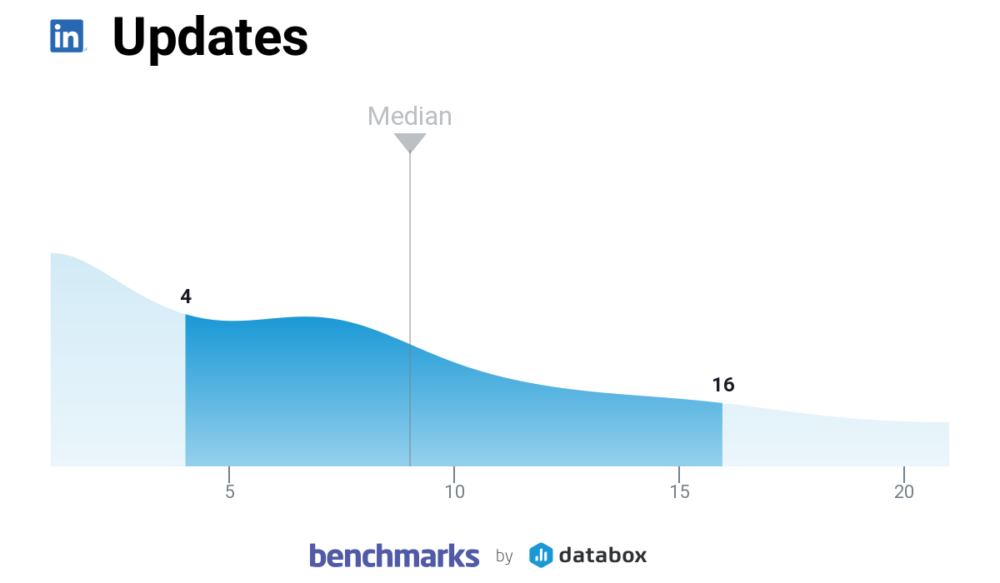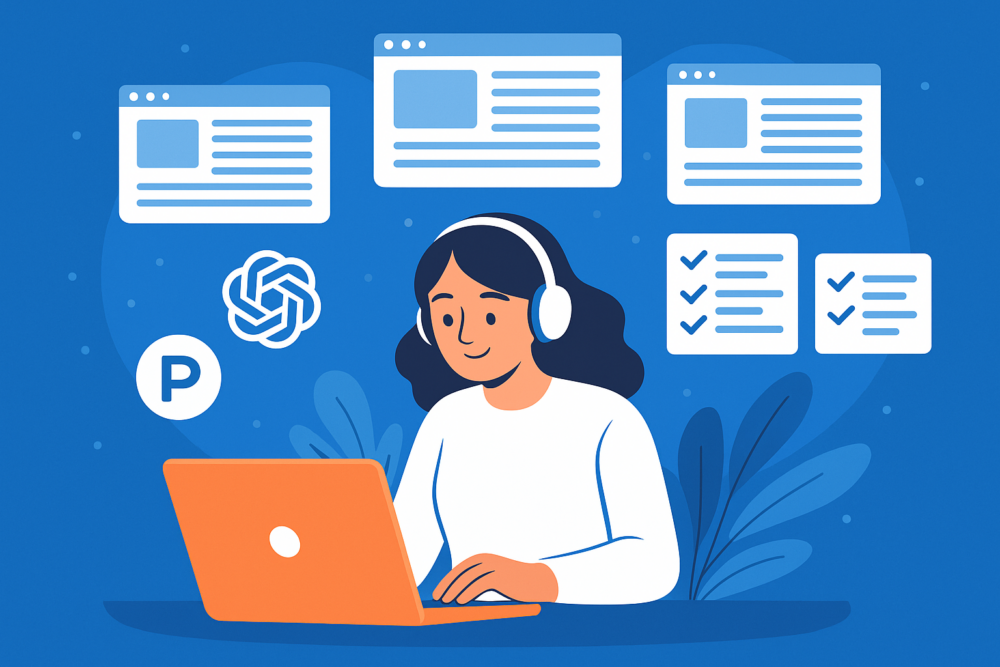Table of contents
Where does your LinkedIn page performance stand?
If take a look at our SMB Benchmark Group for LinkedIn (which includes 1200+ businesses sharing their company page data), we can see that their median number of impressions for January was 2.01k per month.

Their median number of new followers was 21…

And their median number of comments was just 1.

It seems like SMBs could do a much better job at marketing their business on LinkedIn. But, their engagement numbers also show how successful an SMB’s LinkedIn page can get. The top quartile of participants had a median of 5.88k impressions, 77 new followers, and 156 new post likes in January.
If you want to become part of that top percentile or simply strive to (always) improve, you can learn from other businesses’ successes. We recently ran a LinkedIn discussion and surveyed LinkedIn business users to see what tactics worked best for them.
Our discussion included LinkedIn page owners from a variety of industries and experience levels.
The 64 respondents to our survey came from marketing, digital or media agencies (40.63%), business-to-business (B2B) organizations (40.63%), and business-to-consumer organizations (18.75%). Most of them have one to five years of experience using LinkedIn for business.

Out of all of the respondents, 6.25% stated they don’t have a LinkedIn business page, but most of them still use LinkedIn. Just one participant stated they don’t use LinkedIn at all.
Now that you have context behind the people who provided insights, here are the topics you’ll learn from them today:
- How Often Do Companies Post on LinkedIn?
- How Do Companies Use Employee Advocacy on LinkedIn?
- Best Ways to Market a Business on LinkedIn (According to 100+ Marketers and Business Leaders)
- Top Tactics for Measuring Your LinkedIn Company Page’s Success
How Often Do Companies Post on LinkedIn?
Our Benchmark Groups data and survey data unveil how often companies tend to post on LinkedIn.
Let’s look at post-frequency data for our All Companies Group, which includes data from 1100+ companies. The median number of posts per month in January was 9.

Our survey data aligns with our benchmark data. About 40% of survey participants say they post updates multiple times per week.

Consider your posting frequency as you revamp your LinkedIn marketing strategy. You don’t have to post every single day, but most companies post updates at least twice a week.
Related: 53 Social Media Pros Explain the Art of Posting on LinkedIn
How Do Companies Use Employee Advocacy on LinkedIn?
One of the most popular topics in our LinkedIn discussion was employee advocacy — the practice of encouraging employees to share content on LinkedIn. We also covered this concept extensively in our survey.
Almost 69% of survey respondents told us they leverage their employees’ personal accounts to promote their organizations.

The most intriguing part about this finding is that most of the respondents who leverage employee advocacy don’t require it.
More than half don’t require their employees to engage with their company page posts, but they make their posts worthy of sharing, so they do it of their free will. Around 30% have a team of employees who post updates on their personal LinkedIn accounts to promote their companies. Just 9% make employee engagement mandatory.

Jen Spencer, CEO of SmartBug Media, uses a dedicated tool to encourage LinkedIn posts from employees: “We embody a giving-first, share valuable tools and resources approach to the way we market ourselves and try to include everyone—team members and our partners—in the exercise of knowledge-sharing.
Today at SmartBug Media, we leverage PostBeyond by Influitive for broad ground cover across key social channels (of which LinkedIn is a top priority) and have plans in 2023 to further increase engagement via gamification.”
And if you don’t have the funds to invest in another tool, Spencer explains how to do it for free. “Before I had funds to pay for a tool like PostBeyond when I was in early stage SaaS, we did it manually with spreadsheets and Slack reminders.
You have to fund (with strategy, tools, and resources) the initiative, and your people have to be bought into the idea (which means they have to really love what they do and who they do it with).
So, it all comes from within.” Spencer says.
If you’re looking to implement a similar approach in your company, consider using SmartBug Media LinkedIn Post Planning Template to get started.
You don’t have to form a large army of LinkedIn advocates to get this tactic going. Over half of our survey participants count on just two to five employees to promote their organization on LinkedIn.

If you want to join the LinkedIn marketers getting support from their employees, make the experience as frictionless as possible for your team. Assign clear roles or offer resources that make it simple for anyone to share your content.
Best Ways to Market Your Company on LinkedIn (According to 100+ Marketing and Business Leaders)
When we asked survey participants about their most effective LinkedIn marketing tactics, three methods overwhelmingly came out on top. Respondents found the most success in commenting on other people’s posts (73.21%), publishing posts on employees’ personal profiles (67.86%), and publishing updates on their LinkedIn company profiles (67.86%).

The business experts who took part in our LinkedIn discussion and some of our survey respondents had additional tactics to share, including these tips:
- Carefully Plan Your Content
- Participate in Industry Groups
- “Hijack” Your Audience
- Offer Content Your Followers Want
- Invest in Sponsored Content
- Leverage Audio and Video Content
- Keep Your Audience in the Loop
1. Carefully Plan Your Content
The head of partnerships at Teamwork, Logan Lyles, puts plenty of thought into his content frequency and types to get optimal results from his posts.
He sees his results build on each other when he can post frequently — daily, if he can. That task is easier said than done, but he manages it with careful organization. Lyles says, “One thing that helps here is to have:
- An easy spot to capture content ideas
- Recurring times to develop those and draft posts
- A system for planning ahead
I use the board view on a project in Teamwork to drop new cards when I have a content idea in the Ideas column. I keep it simple from there with a recurring calendar block to take ideas from there to Drafted and then move to Posted once they’re published.
The new Scheduled Posts feature that’s rolling out on LinkedIn will help me add even more efficiency to this process.”
Lyles also notices better engagement when he mixes up the content formats he uses, such as GIFs, text-only posts, and carousels.
Lyles says, “By mixing it up, I find that it keeps my content from getting stale.
It also turns one idea into 3-4 posts instead of just one.
For example, I wrote a post about 5 words you should eliminate from your communication with clients (just, kinda, sorta, etc) and it saw some good traction. When I went back to that concept and repurposed a short text-only post into a carousel graphic post with more detail — it saw *even more* traction.”
Using this experience, Lyles has a lesson to share.
“If you find a post or topic that generates a lot of engagement, double-down on it, repurpose that original post, talk about that concept in a different way… Don’t be afraid that you’re simply ‘repeating yourself’!”
Want to get highlighted in our next report? Become a contributor now
Pay close attention to what content performs well, then design your content workflow around those patterns. Different tactics will appeal to different audiences, so lean into what works for yours.
PRO TIP: How to Engage Your Company’s Followers on LinkedIn
Personal branding is one thing, an important thing, but so is helping your company grow. You may not have direct control over who follows you, but you can influence them with your posts, comments, and other kinds of engagement. To do that, you need to know who they are and what their interests are. You can align yourself with your LinkedIn company page followers by analyzing:
- Followers by Industry
- Followers by Company Size
- Followers by Seniority
- Followers by Geography
- Month over Month Improvement
and more…
Now you can benefit from the experience of our LinkedIn experts, who have put together a great Databox template showing all the most important demographics for your LinkedIn company page. It’s simple to implement and start using as a standalone dashboard or in marketing reports!
You can easily set it up in just a few clicks – no coding required.
To set up this LinkedIn dashboard, follow these 3 simple steps:
Step 1: Get the template
Step 2: Connect your LinkedIn account with Databox.
Step 3: Watch your dashboard populate in seconds.
2. Participate in Industry Groups
Many of our survey and LinkedIn discussion participants talked about using channels besides your LinkedIn page to draw more engagement. As survey respondent Cynthia Davies of Cindy’s New Mexico LLC points out, one such route is LinkedIn’s Groups feature.
“One thing that’s worked well for marketing my business on LinkedIn has been participating in industry group discussions,” Davies says. “It helps get me in front of an audience who have a greater likelihood of needing my services, as well as helps me connect with other business owners in my industry.”
Davies adds, “Groups are a great way to connect with potential customers because they’ve chosen to be a part of the group, meaning they’re already going to be more engaged, and more likely to be interested in your services either now or in the future. By being active in groups, you can establish yourself and your business as a valued source of information, which helps to build trust and goes a long way to help increase conversions.”
Join groups relevant to your niche, and start or comment on discussions in them. Watch how group members participate to see how active each group is. More active groups will get your profile in front of more faces, but too much activity can lead to your contributions getting buried.
3. “Hijack” Your Audience
Good, old-fashioned consideration and collaboration can go a long way in earning engagement for your LinkedIn page. Andrew Fraine, co-founder of Automata, uses a technique called “audience hijacking” to build the company’s audience, but you’ll see it’s a practice grounded in compassion.
Fraine says, “We identify other accounts with an audience that we would like to reach, and ‘hijack’ their audience by including those accounts in posts and interacting with their content. It’s important to add real value and reference their work published *off* LinkedIn to provide useful examples and insights to your audience. We use this sparingly, and only tag big accounts in your posts if your insights are relevant.
In general, it’s very difficult to obtain significant organic reach from company accounts (they want you to pony up $$ for that reach). We have found it easier by an order of magnitude to reach our target audience through founder/leadership accounts using these two approaches.”
Simply put, this tactic is all about supporting great things going on in your industry. When we asked Fraine for more details on this “hijacking” technique, Fraine phrased it this way:
“If you see someone or a company in your industry create something awesome, write about it, tag them in your post and give them credit.
It helps them distribute their content, and it’s a bonus if they interact with your post because some percentage of their audience will see your content as well. It’s all about providing some value in exchange for a small piece of their audience’s attention.”
Want to get highlighted in our next report? Become a contributor now
People enjoy feeling appreciated for their hard work. Support other folks in your industry, and chances are they’ll return the favor.
4. Offer Content Your Followers Want
Many people who took part in our LinkedIn discussion emphasized the importance of delivering posts that your audience wants to read. It can be easy to fall into the trap of posting things that you might care about, but your followers don’t.
Jen Allen, who manages community growth at Lavender, offers a list of actions to stop and start to provide meaningful content:
- “Stop using your company page to sell/market your solution.
- Stop talking about the awards you won.
- Stop sharing gated white papers that are thinly veiled ads.
- Stop bragging about 15x ROI.
That stuff is self-absorbed and commoditized, and it’s why it doesn’t stick out from the noise.
- Start asking, ‘Would sharing this post/content with others make me look smart or helpful?’.
- Start creating content that provides a new perspective on problems your buyers are facing, without talking about your solution.
- Start un-gating content. If it’s great content, people will want to keep learning from you. that’s the behavior we’re after.
- Start helping buyers understand the cost of inaction (COI) instead of the ROI of doing something. give them a reason to care about the problem your solution solves.”
Allen has one piece of advice to follow before you try any of these tips, though. “Make sure LinkedIn is a place where your buyers go to learn. I sell to Sales leaders (and they’re notorious lurkers here), but If your buyers aren’t coming here to learn, your time/effort might be better spent in a different channel.”
In addition to employee advocacy, Luke Reynebeau, VP of marketing at Sales Assembly, finds success in the following types of content: “Engaging and entertaining content from the company page. Putting a spotlight and amplifying our customers and partners. Helpful posts sent regularly, meant to speak to and engage our core audience… not act as a distribution method.”
Reynebeau concludes, “The audience growth and traffic come when we’re not always pushing people off-site.”
Eden Bidani, conversion copywriter and acquisition strategist at Green Light Copy, agrees that this value-driven content helps LinkedIn pages succeed. She also notices that successful pages also “show, not tell.”
“Only a handful of companies are actually showing people the value of what they do versus simply telling people they can deliver value.
The ones that do share content like ungated demo posts, ‘how to’ posts, and podcast and interview clips on topics that readers are interested in. This also delivers value to the reader without expecting conversion[.”
Want to get highlighted in our next report? Become a contributor now
Bidani relates this practice back to the concept of delivering value she initially explored. Both approaches put the reader first instead of engagement.
As you figure out how to deliver value with your content, look for high-performing posts and think about what aspects of their content led to their success. These insights will help you create updates your followers will look forward to.
Related: 16 Ways To Measure Social Media Engagement Using Only Google Analytics
5. Invest in Sponsored Content
Modern social media strategies often have a “pay-to-win” element to them due to advertising algorithms, and LinkedIn is no different. Fortunately, LinkedIn’s sponsored content feature lets you target the exact audiences you want to see your posts.
“Sponsored content is a beneficial way to drive quality leads into your sales funnel,” says survey respondent Ziera Soda of Altitude Marketing. “For Altitude Marketing, sponsored content on Linkedin has allowed us to accurately target specific audiences for each client and connect with those qualified and interested in our service offerings. Our Linkedin lead generation ads and our document ads are high performing.”
Soda continues, “We also have higher quality conversions in our sponsored content ads that have longer intro texts. We anticipate that sponsored content will continue to be a successful marketing model to implement going into the new year.”
If you haven’t used social media advertising before, you might wonder how much you should spend to get results. According to our Linkedin Ads Benchmark for All Types of Businesses, companies spend a median amount of $1,811.95 on LinkedIn ads.

Benchmark Your Performance Against Hundreds of Companies Just Like Yours
Viewing benchmark data can be enlightening, but seeing where your company’s efforts rank against those benchmarks can be game-changing.
Browse Databox’s open Benchmark Groups and join ones relevant to your business to get free and instant performance benchmarks.
But, don’t feel pressured to spend a lot on sponsored content right away. Test the waters with a post or two, then build up as your budget allows.
Related: LinkedIn Ads Best Practices: 10 Tips for Running Successful Campaigns
6. Leverage Audio and Video Content
One of the trickiest parts of posting on LinkedIn consistently can be finding content to post in the first place.
Nemanja Zivkovic, CEO and founder of Funky Marketing suggests one way to create a regular source for LinkedIn posts: starting a series of audio or video content, such as a podcast or interview series.
Zivkovic says, “We select several people from our target group (but those that are active and have an audience) and invite them to be guests.
Everyone likes to talk about themselves for an hour. We prepare a set of questions, ask all that we need to find out the way they’re working, and the way they’re investing in new products or services, and we take them through the buyers’ journey.”
This long-form recorded content gives the Funky Marketing team a video to post on YouTube and audio to upload to Anchor. From there, “We then repurpose the content into smaller pieces of video content or audiograms (6-8 pieces out of an hour of long-form content), add headlines and transcription, and use it on Linkedin, primarily.
We send all the versions to the guests, so they can share them on their profiles.
The guest speaker model lends itself well to LinkedIn engagement and distribution. Zivkovic says, “We use pieces with guests on our company page, where we practically build our company brand on the personal brands of our guests.
We tag them, and quote them, so their network can see it. Also, at the same time, we’re connecting with respectable people from the company, to make our content more visible.
The pieces of content where we’re talking are going to the personal profile of the person hosting the podcast.”
As a bonus, the guests on these shows have the potential to become future clients. “That’s how we educate potential clients with content that hits all stages of their buyers’ journey, and, at the same, time, we start a long-term relationship with them. After the podcast, we nurture that relationship and move slowly to the conversation where we can show them the way we help them solve their problems (they already know we can, at this point),” Zivkovic says.
Survey respondent Jessica Shee of iBoysoft notices similar success with video. “ Short-form videos have worked really well for us. The popularity of videos on social media has grown significantly in the past year. And we’ve jumped on the bandwagon. We’ve noticed that people interact much more on shorter videos than they do on long-form. Short videos convey our message directly and without any fluff content. Which has been very effective,” Shee says.
Related: LinkedIn Video Ads: Best Practices & Ad Specs
7. Keep Your Audience in the Loop
Another possible content well for your company LinkedIn page is your company’s events. If you typically include people from outside your company in your events, you’ll have a new channel for connecting with your industry.
Here’s how Sebastian Kuhnert, managing director at chess24, shares updates on company events to stay active on LinkedIn: “At chess24, we share chess news with a focus on the events organised by us with the world chess elite and the world’s rising young chess stars. Personally, I share impressions from our events and celebrate our partners and sponsors that allow the events to happen, tagging partners and their responsible stakeholders, and celebrating the respective theme of the tournament which is usually innovation or sustainability-related. This has been very successful for us.”
Notice how Kuhnert tags relevant people when he has the chance, like some of the other experts who contributed to our discussion.
We asked Kuhnert if this approach helps chess24 get more partnerships and sponsorships since they have such a heavy focus on partners and sponsors in their tagging strategy. The chess24 account chimed in to tell us, “Absolutely, Sebastian has inspired others in the team to do the same and even staff of our partner companies, which made many of our events get massive LinkedIn appreciation. Partner retention has been high, and we have been getting some sponsorship interest also through Sebastian’s LinkedIn inbox.”
Top Tactics for Measuring Your LinkedIn Company Page’s Success
You may have noticed that many of the tips we offered rely on you monitoring your LinkedIn page’s performance. With so many analytics tools out there, which should you prioritize in your strategy?
No worries — you don’t have to make things complicated. When we asked survey respondents about their tracking methods, just under 40% stated they use LinkedIn’s native analytics.

If you have third-party tools that help you connect LinkedIn to the rest of your pipeline, you can use them like some of our other respondents. But, the most popular response by far was LinkedIn analytics. Use the tools you have at your disposal and adjust from there as you integrate your LinkedIn performance into your greater marketing strategy.
Once you find the right tool for your analytics workflow, identify the metrics that matter most for your page. When we surveyed 50 LinkedIn business page users, some of the metrics they recommended tracking included engagement rate, impressions, and clicks. You can find the full list in our report.
Get LinkedIn Data Benchmarks on 1,000+ Companies Using Databox
Apart from regularly monitoring your LinkedIn performance, having access to other organizations’ performance data can be very helpful in evaluating your own strategy and setting better, more realistic goals. This is one of the reasons we launched Databox Benchmark Groups. With our tool, you can:
- Improve your overall competitive analysis process
- Stay on top of current trends and forecast new ones
- Plan and set goals
- Celebrate your wins
And more.
There are 1,000+ metrics you can benchmark, from 50+ of the most popular marketing, financial, sales, and SEO tools.
And all of this is completely free.
Here is a list of our open LinkedIn groups:
- LinkedIn Company Page Benchmarks for All Companies
- LinkedIn Company Page Benchmarks for SMBs
- LinkedIn Company Page Benchmarks for B2B Companies
- LinkedIn Company Page Benchmarks for B2C Companies
- LinkedIn Company Page Benchmarks for Small Companies (1-50 employees)
- LinkedIn Company Page Benchmarks for Large Companies (250+ employees)
- LinkedIn Benchmarks for Marketing Agencies
- LinkedIn Company Page Benchmarks for SaaS Companies
Sign up for Databox Benchmark Groups today to get instant access to our benchmark data for LinkedIn and all of your other favorite platforms.

















